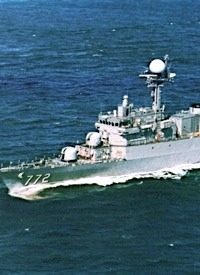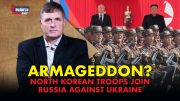
Reuters cited an April 22 Yonhap News Agency report that the South Korean military believes a torpedo fired from a North Korean submarine sank its navy corvette, the ROKS Cheonan, on March 26. The findings were based on intelligence gathered jointly with the United States.
The ship had a crew of 104 men at the time of sinking, with 58 crew members being rescued and another 46 members unaccounted for.
"North Korean submarines are all armed with heavy torpedoes with 200 kg (441 lb) warheads," the military source was quoted by Yonhap. "It is the military intelligence’s assessment that the North attacked with a heavy torpedo.
"The military intelligence has made the report to the [presidential] Blue House and to the Defense Ministry immediately after the sinking of the Cheonan that it is clearly the work of North Korea’s military," the source was quoted as saying.
In a follow-up report on April 23, Reuters quoted South Korean President Lee Myung-bak’s statement to a group of foreign journalists: "Just as the investigation is being conducted with international cooperation, we’ll try to cooperate with the international community in taking necessary measures when the results are out.”
An article published in the Korea Times for April 15 noted:
Experts said [on April 15] a powerful external explosion is the likely cause of the sinking of the naval ship Cheonan in the West Sea as the broken section of its stern part appears to have been ripped apart and the severed edges appear badly damaged.
They said the explosion seems to have occurred underwater, below the 1,200-ton warship, as the upper metal structure of the warship was bent upward by a “bubble jet“ effect.
They said the possibility of a metal fatigue fracture or an implosion is slim, claiming that the ship appears to have been torn into two parts as a result of a torpedo or a sea mine exploding underwater.
Analysts agreed that an internal blast is an unlikely cause, given that most of the weapons on the frigate, including 76mm and 40mm guns under which ammunition is stored, remain intact.
Reuters commented that the Yonhap news report appears to indicate clearly that Seoul blames Pyongyang for the sinking. While the report puts political pressure to make some sort of response on South Korean President Lee, analysts do not see it sufficient to trigger a war between the two Koreas, because a war would be harmful to the South Korean economy, while at the same time improving North Korean leader Kim Jong-il’s standing at home.
Speaking to reporters at a NATO foreign ministers’ meeting in Estonia, U.S. Secretary of State Hillary Clinton urged North Korea not to take “provocative actions”: “We have said time and time again that the North Koreans should not engage in provocative actions, and that they should return to six-party talks.”
The six-party talks are a series of ongoing negotiations seeking to reach a peaceful resolution to North Korea’s nuclear weapons program. The six participating states include: the People’s Republics of China, the Republic of [South] Korea, the Democratic People’s Republic of [North] Korea, the United States, the Russian Federation, and Japan.
"I hope that there is no talk of war, there is no action or miscalculation that could provoke a response that might lead to conflict. That’s not in anyone’s interests," Clinton said.
These latest tensions are but another reminder of the folly usually referred to as the Korean War, and the UN-orchestrated failure of the anti-communist forces, to which North Korea owes its existence.
The Korean War was fought under the auspices of the United Nations, which maintained control of U.S.-led military operations against the Chinese-backed communist North. During the war, all military orders and directives sent from Washington and the Pentagon to the American commanders in Korea were first supplied to several offices at UN headquarters. This control prevented General Douglas MacArthur from securing victory against the communists.
The Korean peninsula has been one of the world’s “hot spots” ever since.
Photo of the ROKS Cheonan: AP Images



